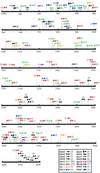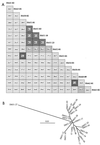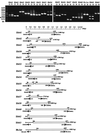Identification and distribution of new insertion sequences in the genome of alkaliphilic Bacillus halodurans C-125
- PMID: 11418576
- PMCID: PMC95325
- DOI: 10.1128/JB.183.14.4345-4356.2001
Identification and distribution of new insertion sequences in the genome of alkaliphilic Bacillus halodurans C-125
Abstract
Fifteen kinds of new insertion sequences (ISs), IS641 to IS643, IS650 to IS658, IS660, IS662, and IS663, and a group II intron (Bh.Int) were identified in the 4,202,352-bp genome of alkaliphilic Bacillus halodurans C-125. Out of 120 ISs identified in the C-125 genome, 29 were truncated, indicating the occurrence of internal rearrangements of the genome. The ISs other than IS650, IS653, IS660, and IS663 generated a 2- to 9-bp duplication of the target site sequence, and the ISs other than IS650, IS653, and IS657 carry 14- to 64-bp inverted repeats. Sequence analysis revealed that six kinds of ISs (IS642, IS643, IS654, IS655, IS657, and IS658) belong to a separate IS family (IS630, IS21, IS256, IS3, IS200/IS605, and IS30, respectively) as a new member. Also, IS651 and IS652 were characterized as new members of the ISL3 family. Significant similarity was found between the transposase (Tpase) sequences between IS650 and IS653 (78.2%), IS651 and IS652 (56.3%), IS656 and IS662 (71.0%), and IS660 and IS663 (44.5%), but the others showed no similarity to one another. Tpases in 28 members of IS651 in the C-125 genome were found to have become diversified. Most of the IS elements widely distributed throughout the genome were inserted in noncoding regions, although some genes, such as those coding for an ATP-binding cassette transporter/permease, a response regulator, and L-indole 2-dehydrogenase, have been mutated through the insertion of IS elements. It is evident, however, that not all IS elements have transposed and caused rearrangements of the genome in the past 17 years during which strain C-125 was subcultured under neutral and alkaline conditions.
Figures






References
-
- Abarca F M, Toro N. Group II introns in the bacterial world. Mol Microbiol. 2000;38:917–926. - PubMed
-
- Berg D E, Howe M M, editors. Mobile DNA. Washington, D.C.: American Society for Microbiology; 1989.
MeSH terms
Substances
Associated data
- Actions
- Actions
- Actions
- Actions
- Actions
- Actions
- Actions
- Actions
- Actions
- Actions
- Actions
- Actions
- Actions
- Actions
LinkOut - more resources
Full Text Sources
Other Literature Sources
Molecular Biology Databases
Miscellaneous

